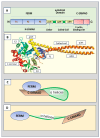Radixin: Roles in the Nervous System and Beyond
- PMID: 39457653
- PMCID: PMC11504607
- DOI: 10.3390/biomedicines12102341
Radixin: Roles in the Nervous System and Beyond
Abstract
Background: Radixin is an ERM family protein that includes radixin, moesin, and ezrin. The importance of ERM family proteins has been attracting more attention, and studies on the roles of ERM in biological function and the pathogenesis of some diseases are accumulating. In particular, we have found that radixin is the most dramatically changed ERM protein in elevated glucose-treated Schwann cells.
Method: We systemically review the literature on ERM, radixin in focus, and update the roles of radixin in regulating cell morphology, interaction, and cell signaling pathways. The potential of radixin as a therapeutic target in neurodegenerative diseases and cancer was also discussed.
Results: Radixin research has focused on its cell functions, activation, and pathogenic roles in some diseases. Radixin and other ERM proteins maintain cell shape, growth, and motility. In the nervous system, radixin has been shown to prevent neurodegeneration and axonal growth. The activation of radixin is through phosphorylation of its conserved threonine residues. Radixin functions in cell signaling pathways by binding to membrane proteins and relaying the cell signals into the cells. Deficiency of radixin has been involved in the pathogenic process of diseases in the central nervous system and diabetic peripheral nerve injury. Moreover, radixin also plays a role in cell growth and drug resistance in multiple cancers. The trials of therapeutic potential through radixin modulation have been accumulating. However, the exact mechanisms underlying the roles of radixin are far from clarification.
Conclusions: Radixin plays various roles in cells and is involved in developing neurodegenerative diseases and many types of cancers. Therefore, radixin may be considered a potential target for developing therapeutic strategies for its related diseases. Further elucidation of the function and the cell signaling pathways that are linked to radixin may open the avenue to finding novel therapeutic strategies for diseases in the nervous system and other body systems.
Keywords: ERM; cancer; neurodegeneration; peripheral nerve injury; phosphorylation; radixin.
Conflict of interest statement
The authors declare no conflicts of interest.
Figures




Similar articles
-
Ezrin/radixin/moesin proteins differentially regulate endothelial hyperpermeability after thrombin.Am J Physiol Lung Cell Mol Physiol. 2013 Aug 1;305(3):L240-55. doi: 10.1152/ajplung.00355.2012. Epub 2013 May 31. Am J Physiol Lung Cell Mol Physiol. 2013. PMID: 23729486 Free PMC article.
-
Rho-kinase phosphorylates COOH-terminal threonines of ezrin/radixin/moesin (ERM) proteins and regulates their head-to-tail association.J Cell Biol. 1998 Feb 9;140(3):647-57. doi: 10.1083/jcb.140.3.647. J Cell Biol. 1998. PMID: 9456324 Free PMC article.
-
Rho kinase activates ezrin-radixin-moesin (ERM) proteins and mediates their function in cortical neuron growth, morphology and motility in vitro.J Neurosci Res. 2007 Jan;85(1):34-46. doi: 10.1002/jnr.21102. J Neurosci Res. 2007. PMID: 17075902
-
Perspectives for Ezrin and Radixin in Astrocytes: Kinases, Functions and Pathology.Int J Mol Sci. 2019 Aug 2;20(15):3776. doi: 10.3390/ijms20153776. Int J Mol Sci. 2019. PMID: 31382374 Free PMC article. Review.
-
A biophysical perspective of the regulatory mechanisms of ezrin/radixin/moesin proteins.Biophys Rev. 2022 Jan 28;14(1):199-208. doi: 10.1007/s12551-021-00928-0. eCollection 2022 Feb. Biophys Rev. 2022. PMID: 35340609 Free PMC article. Review.
References
Publication types
LinkOut - more resources
Full Text Sources
Research Materials

